Omicron has made its way through every major country except one – China. Its time seems to have come. As I noted on Monday, China had already locked down 60 million people amid rapidly rising case counts. Unlike previous rounds where China was able to fully take extreme measures only it could take but that held the promise of physically working, this round’s efforts seem like the exact kind of hope that is not a strategy. They’ll help to slow things down, sure, absolutely, but I can’t find a physical model where they are enough. Things will get out to the rest of China, and locking down over a billion people Chinese-style is simply not an option for any length of time. The resources are not there.
Meanwhile, Europe and the United States are dealing with the rise of BA.2, which is overtaking BA.1. My estimate is it is 25% more infectious than BA.1, which means its raw numbers should indeed be increasing for now, putting as at risk for an additional wave. I do not expect anything that needs to be disruptive, and I expect little appetite for renewed restrictions, but we have indeed done stupider things many times.
So it’s not the best time to notice that it looks like the administration really is out of money for Covid-related things. The standalone bill to provide the funding seems unlikely to pass the Senate. We might actually soon be in a situation where the federal government can spend no money on either vaccine research, other pandemic preparedness or even things like testing and treating the uninsured. Alas, the restrictions that do harm are not the interventions the government will find itself unable to fund.
Executive Summary
- BA.2 is taking over for BA.1, perhaps resulting in a small new wave.
- China is probably about to be forced out of its Zero Covid policy.
- A new highly promising therapeutic has been announced.
Let’s run the numbers.
The Numbers
Predictions
Prediction from last week: 170k cases (-25%) and 7,050 deaths (-22%).
Results: 190k cases (-16%) and 8,609 deaths (-6%).
Prediction for next week: 180k cases (-5%) and 6,300 deaths (-10%).
Note: Deaths excludes a -4,096 count in MA, and excludes 2,300 backlog deaths from SC.
After predicting too many cases for a few weeks running now I predicted too few. Part of that is the rise of BA.2, but the other half is adjustments from previous results causing me to doubt that our behaviors were adjusting as much as I expected to new conditions. It seems that has finally turned around. I expect both trends to continue, and we are probably near the local bottom.
The lack of a further decline in deaths is getting increasingly weird. The implied CFR keeps going up, no matter what pattern of time lag one uses. I do not understand it, but at some point one’s predictions have to fold even if there’s no explanation of why. The number of reported tests is declining but not enough to make us be missing that many more cases.
My new theory is that these are mainly ‘with Covid’ deaths rather than ‘from Covid’ deaths and the definition somehow includes anyone with recent Covid, so people who have actually fully recovered, who then died of something else, are being counted as Covid deaths. I haven’t heard that expressed elsewhere, but if that’s not true, then I got nothing. This number is too high and it does not make sense.
Deaths

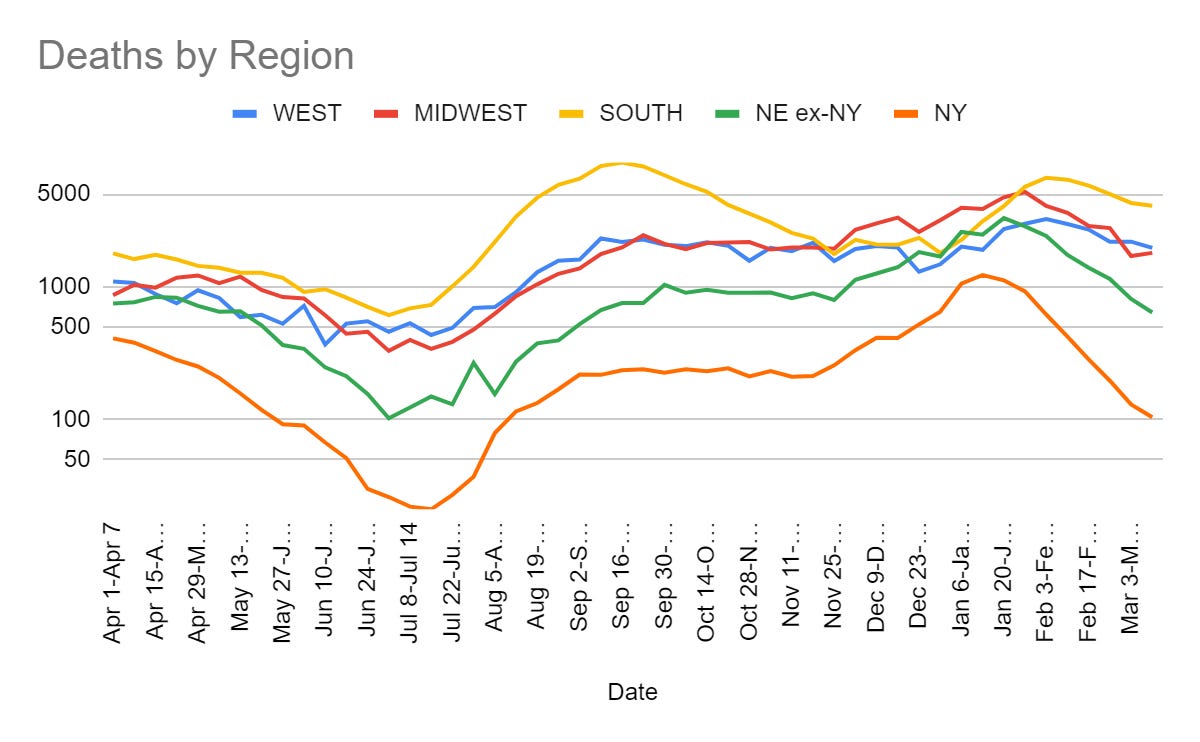
This isn’t going to make more sense if I keep looking at it more. Something in the way this data is being tabulated is super fishy.
Cases

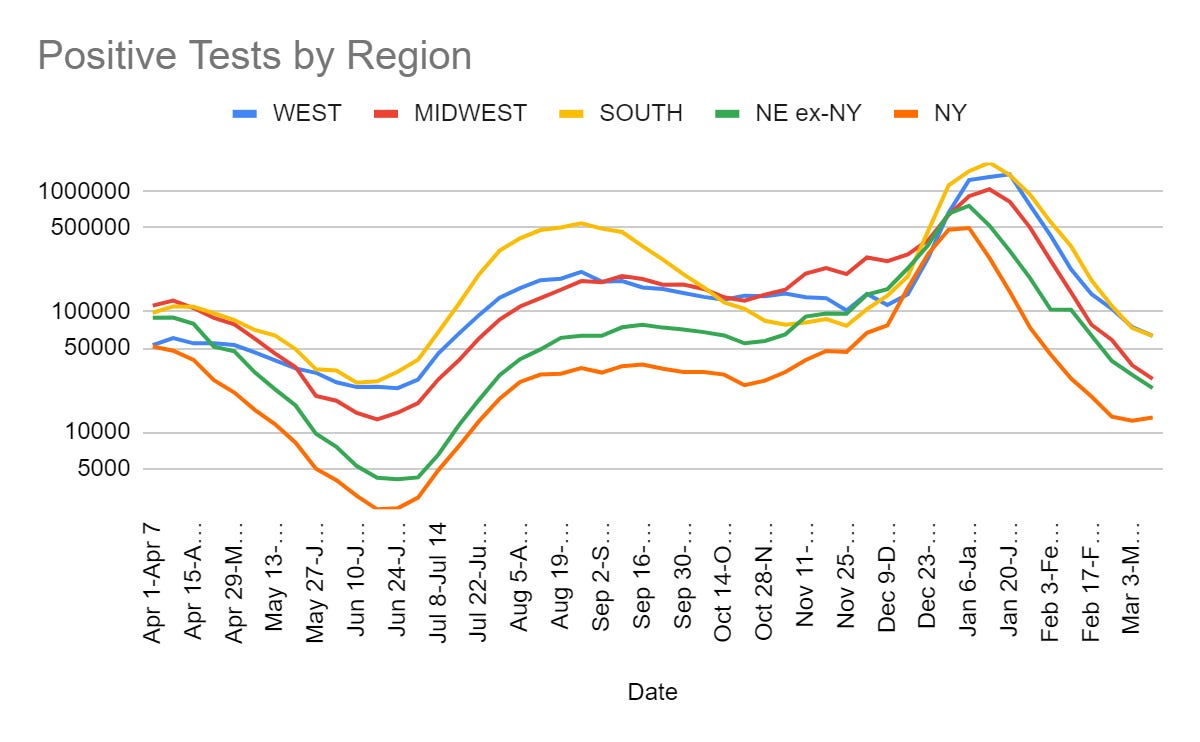
Things are still declining in most places, although they have begun creeping up here in New York, which makes sense given that we had our peak slightly earlier as well. Otherwise, the uniformity of timing is remarkable.
Europe, South Korea and Hong Kong
Cases in Europe are up, and a common line is that Europe is ‘ahead’ of us by a few weeks and represents America’s pandemic future.
Here is the situation now, with the USA on to show the contrast.
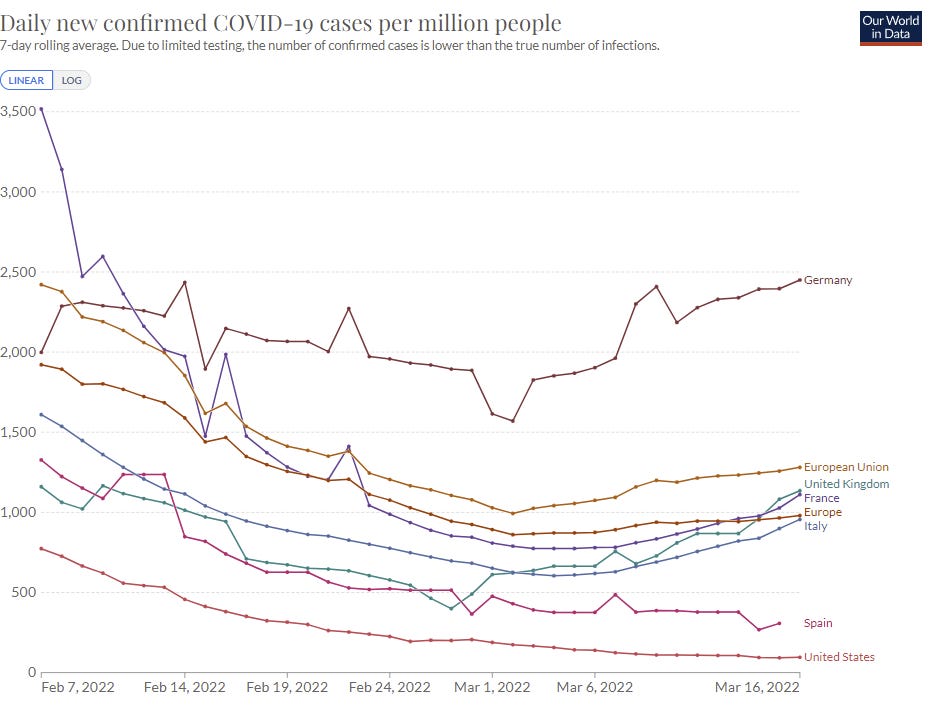
For context, zooming out and adding Denmark, Hong Kong and South Korea.
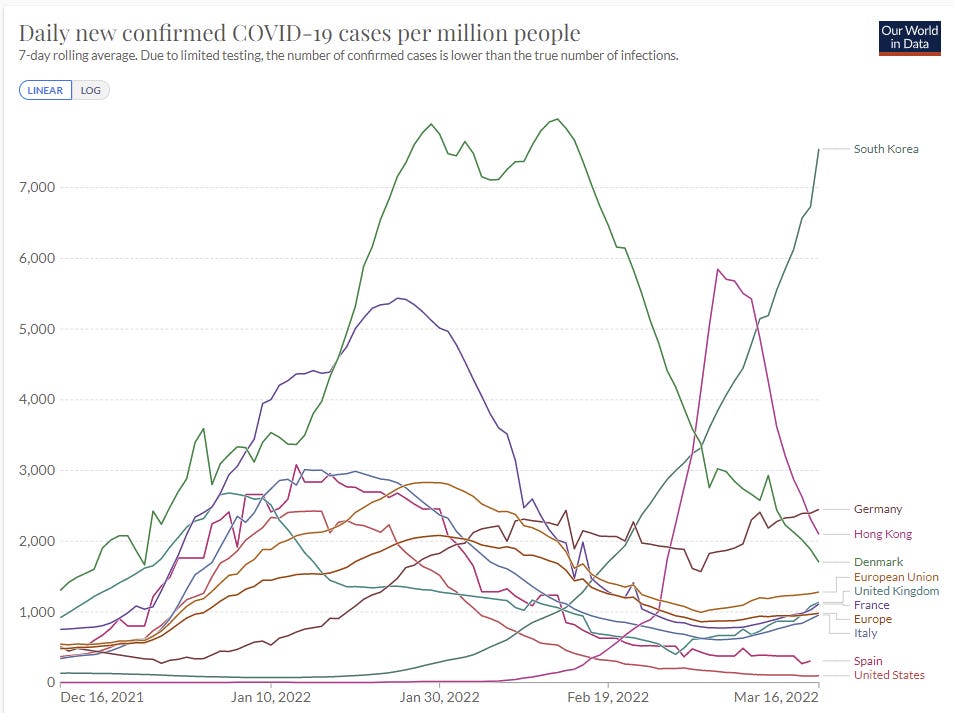
There is real concern here. Cases in many places are going up again, including the average for all of Europe or the European Union.
Notice that the United States peaked in a similar place to Europe overall, but is now dramatically lower – even at its trough Europe had 860 cases/million/day and America is currently under 100, much less than every major Western European nation.
For comparison, here’s deaths, especially to note that American deaths are relatively high even now, although that will change.
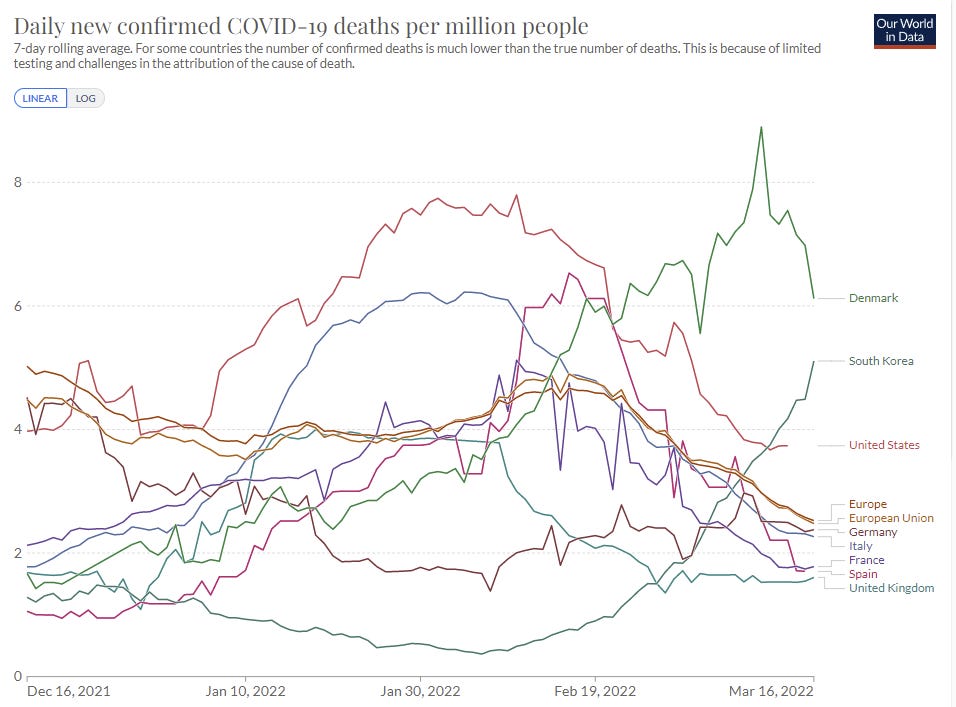
For whatever reason, current conditions in the United States are far more favorable in terms of spread than conditions in Europe. It seems highly plausible that BA.2 could be enough to make things in Europe importantly bad but not do so in the United States. Everyone talking about this will say the opposite, it seems, citing our vaccination rate, because Covid-19 is supposed to be a morality play, despite its stubborn refusal to adhere to the script.
See the sections below on BA.1 vs. BA.2 for more discussion but I believe BA.2 to be ~25% more infectious than BA.1. This is indeed enough to turn things back around and make cases rise again in Europe for a while, but the chances of things peaking substantially higher than the BA.1 wave seem quite low, and that wave was highly survivable.
Thus, in Europe this looks like mainly a political battle. There will doubtless be calls to return to doing marginally effective but highly annoying prevention efforts, including many (like vaccine requirements) that have no practical effect on the relevant timelines. It will be important to push back hard against this.
One additional note there is that I expect the war to help redirect people’s need to Do Something in a more useful direction. It is a lot easier to avoid needless panic about Covid-19 when events have given something that, no matter your perspective on it, is very much worth panicking about, and also a very practical, very real humanitarian refugee crisis. If you want to do something good, there’s something very good to do.
Things in South Korea are mind-bogglingly out of hand.

South Korea does test more than the West does, but still, my lord that is a lot. The good news is this cannot continue for long, since there are only 100% of the people around to get infected. A peak this high means a rapid peak and a rapid decline.
I have not seen any stories about rushing medical assistance in during their time of need, but this is likely in the short term an even more pressing humanitarian crisis than Ukraine, given the extra deaths that would result from medical system collapse.
Hong Kong is on the way back down in its official case counts and the descent is super rapid, but I have seen claims that this is an illusion caused by a phase change in testing procedures – I don’t know either way. I hope this is incorrect.
China
It seems increasingly clear that China has lost. The will to do what it would actually take to stop Omicron simply is not there.

That’s not to say that is a mistake. What it would take would have been dramatic, and how dramatic it would have to be rises each day that such actions are not taken, if it was even possible at all.
This is all mostly a reiteration of the situation from Monday, except that there is now that much less hope that things could be otherwise.
Here’s the Washington Post on the situation.
On Tuesday, the country’s economic czar Liu He cautioned that under the “complex situation,” pandemic measures must be balanced with economic and social development to “keep the economy operating within a reasonable range” and maintaining stable capital markets — a possible reference to how the draconian lockdown measures used previously could affect the economy.
You don’t get to do that. Balance means failure. There is no ‘keep the economy operating within a reasonable range’ other than winning, and then resuming the work. If the economics minister is talking like this, it seems like this is over.
The citizen complaints are also telling, I want to highlight this one in particular.
“Three years. I don’t dare get sick, and don’t even talk about having children. You don’t know what they might face,” one Internet user wrote under a hashtag for the issue that had been viewed more than 40 million times in two hours.
The madness of Covid, that it would drive one to not have children for fear of it. There are so many things like this that people let talk them into giving up having a family. Do not let this happen to you.
The ‘don’t dare get sick’ is also telling. Having a population in fear of what will happen to them if they are known to be sick is not a healthy long term situation.
As always, this could simply be an outlier anecdote, so take it in with caution.
The core problem is, as noted in the last Omicron post, they’re using half measures, and those measures cannot possibly work in the sense of keeping an outbreak fully contained.
Many more areas have implemented less stringent restrictions on movement between provinces. Flights going into Shanghai will be diverted to other cities from March 21 until May 1. All those entering Beijing must undergo a nucleic acid (PCR) test 72 hours after arrival, on top of having a negative coronavirus test within the past 48 hours.
In Tianjin, like in many cities, residents have been ordered not to leave for nonessential travel. In Shanghai, those who must leave the city, as well as those entering the city, must show a negative nucleic acid test taken in the past 48 hours.
This Reuters analysis echoes this seeking of ‘balance’ by Chinese officials. I agree that the next two weeks will be telling for their ability to contain, the difference is I have a strong expectation of what will be told.
I do still think it is possible that China achieves containment and retains its zero Covid policy in reality but the chances are in the single digits and fading fast.
So what happens now? What will it take for China to abandon the zero Covid policy when cases have already been observed in 28 of its 31 regions?
My presumption is it will take time. Logically speaking, we can see that the zero Covid policy is doomed to failure. In terms of saving face and who wants to tell Xi that the policy is done, it is not yet time. China’s levels of cases are still extraordinarily low, and perhaps things will all work out.
That is, of course, exactly the same kind of thinking of many in the West who tried such hopes and half-measures. It stands in contrast to China’s previous efforts, which were both very serious and surprisingly (to me at least) successful.
What I don’t know is how much time. What makes it sufficiently clear that China will pivot to doing its best to handle the inevitable? To implementing policies to flatten the curve and hopefully minimize how many people die, while keeping their economy from taking too much damage? That is indeed ‘balance’ but it needs to be balance that accepts that containment has failed.
Then the next question is, once China gives up zero Covid, what happens next?
The optimistic picture is that things work out like they did in Japan (or like Omicron in India). A rapid rise, but then a peak well before the situation turns critical and everyone is overwhelmed, somehow managing to turn things around while most remain uninfected. Taiwan is also a hopeful model here, and in some ways is the closest parallel.
Hong Kong and South Korea suggest the other path. A very steep climb up fueled by an immunologically naïve population, leading to a peak that no hospital system could handle, and a lot of deaths. I’ve seen reports that Hong Kong’s peak in positive tests comes from a change in testing procedures as things were overwhelmed, and we won’t know for sure until deaths start to decline again. Things look very bad.
China’s prevention policies under non-zero Covid will help determine which world they will live in, both official policies and private decisions. If they are in the bad worlds, then once things start to take off there will be urgent need to slow things down to give the medical system more time. China should hopefully be able to make unusually good use of time once they admit to the situation, being able to do things like construct hospitals within days.
The key is not to jump the gun. Once it is clear you cannot maintain zero Covid, unless you’re racing to secure medical supplies and other urgent matters and can get a big dividend from that,locking things down now, before the crisis arrives in earnest, is exactly the wrong thing to do. China, like everyone else, has a limited amount of capacity to impose restrictions on its people. Such moves are economically and socially costly, and require many resources that are in limited supply. This is very much a limited ammunition, ‘don’t fire until you see the whites of their eyes’ type of scenario. You’d want to wait until things were about to get rather desperate, then lock down hard to try and contain the peak while limiting the downsides, and hope to maintain that until the peak was over.
Starting that process now for over 50 million people is burning up those precious resources. If China extends that more in vain attempts at early containment, it had better fully work in ways I don’t expect to be possible at this point. Otherwise, things will only end up being worse. Potentially much worse.
If we get the optimistic scenario, China will be adapting to using Covid prevention procedures in widespread fashion indefinitely, but ordinary prevention procedures will combine with cultural factors favoring prevention and conforming to authority and with sensible deployment of resources to allow China to reach equilibrium without having to first infect a ton of people. There will be a modest hit to economic activity and supply chains, but not a widespread human tragedy and not too many serious lockdowns either. Factories that are important would use lots of testing and high quality masks, isolation and ventilation to stay operational.
I think this is the less likely way for things to go, but it’s definitely plausible, so I’d give it a maybe 25% chance once full containment fails.
If that’s not enough, there is little middle ground between that and a situation not as bad as (due to lower density) but centrally similar to South Korea or Hong Kong, which has the other 75%.
Also note that the peak won’t look as high as it does in Hong Kong or South Korea because China is very big and far less interconnected, so its peaks will be more local and diffused in time. Depending on ability to shift medical resources this could be a big advantage in minimizing human costs, with different cities and regions peaking at different times over several months.
This strangely suggests things like ‘let the virus rip inside Jinin now while quarantining the city from the outside and rushing in treatments’ if you fully know that’s the path things will take, but I presume this is simply impossible even if it was correct.
I wish China all the best and all the luck in getting through this. There may be a mid-week update if there is a substantial change in the situation.
Great News, Everyone
New therapeutic just dropped. From the people who brought you repurposed Fluvoxamine, this morning we give you… Peginterferon Lambda (original article).
The Phase 3 TOGETHER study of Lambda is the second largest study to date of a COVID-19 therapeutic. Final analyses evaluated data from 1,936 patients, with 84% of patients having received at least a single dose of any COVID-19 vaccine.
Final analyses using a Bayesian analytic framework showed:
- Lambda highly superior compared to placebo on the primary endpoint, with a probability of superiority of 99.91%, surpassing the prespecified superiority threshold of 97.6%
- 50% risk reduction was observed [95% Bayesian credible interval (95% BCI): 23–69%] of COVID-19-related hospitalizations or emergency room visits compared to placebo in patients treated ≤7 days of symptom onset
- 2.7% of patients (25 / 916) who received Lambda were hospitalized or had ER visits through Day 28, compared to 5.6% of patients (57 / 1020) who received placebo
- Risk reduction of COVID-19-related hospitalizations was observed:
- 42% (95% BCI: 5–66%) risk reduction when treated ≤7 days of symptom onset
- 60% (95% BCI: 18–82%) risk reduction when treated ≤3 days of symptom onset
- One COVID-19-related death in Lambda group; four in placebo group
- Incidence of any treatment emergent adverse events was similar between Lambda and placebo groups, which were primarily injection site reactions
- ABOUT PEGINTERFERON LAMBDA
Lambda is a late-stage, first-in-class, type III interferon (IFN) that stimulates immune responses that are critical for the development of host protection during viral infections and has been well-tolerated in clinical studies.Lambda is to be administered as a single subcutaneous injection so that it can be prescribed and administered at the first sign of infection or at first awareness of an exposure, potentially helping patients avoid severe illness that can lead to hospitalization and death.
The biological frameworks appear distinct, so chances are this will be cumulative with the effects of Paxlovid, and the treatment appears well-tolerated.
If this indeed cuts risk in half again, once we have sufficient supply it seems even more clear that we can shrug off additional waves.
That’s the catch. We have not yet heard anything about supply, so it might be quite a while before this has a major impact.
Physical World Modeling
New Omicron severity paper dropped (paper).


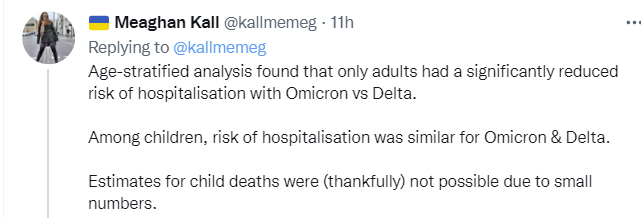


Lots of charts in the thread and in the paper, for the curious. All of this seems consistent with previous model. For kids, I’m ready to accept that relative risk to kids is higher because risk in adults is lower and risk in kids mostly didn’t change, meaning they’re somewhat less additionally protected in relative terms but still absurdly well protected.
Mask study purporting to show that masks stop Covid spread in schools is bad. Really, really bad. Shows the opposite of what it claims kind of bad. Criminal levels of bad. Seriously, this is super bad only not as good. They had a response rate of under 1%. They looked only at secondary infections, when primary infections very much told the opposite tale. They therefore looked only at contact tracing claims, which in many places automatically excluded anyone masked assuming they could not spread Covid. Seriously, wow, if not updating in the opposite direction you are making a mistake.
An argument that future variants will have unknown/random severity. I don’t fully agree, as severity does play a big role in our reaction, but mostly true as far as it goes assuming all such variants are naturally evolving. We did indeed ‘get lucky’ with Omicron, again assuming it was luck.
Thread about recombinants that might combine Delta and Omicron. Mostly seems like no need to be concerned with what we are seeing. If something happens here it would be soon since Delta seems to be going away.
Severity for Omicron continues to look very good (as in, smaller, less than, reduced) in mRNA-vaccinated, previously-exposed areas. This thread looks at Denmark. It’s full on ‘with Covid’ territory.


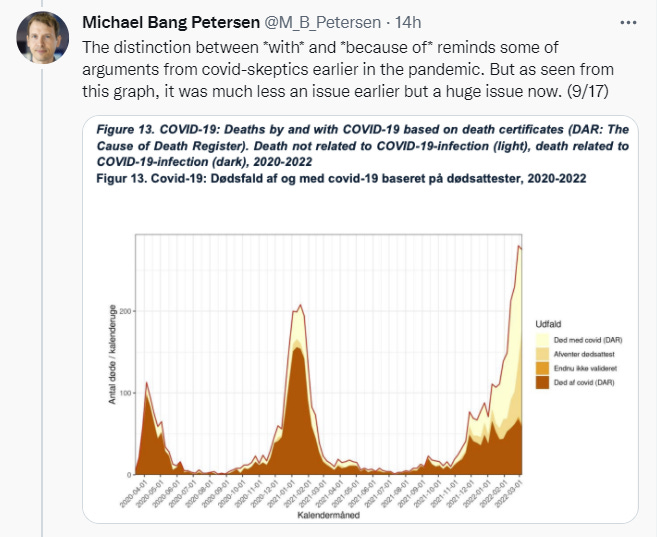


The thread points out correctly that this is largely due to there being a lot of testing in Denmark, so lots of mild cases are caught. But the physical implication is that if you get Covid, within the next 30 days your chance of death only rises 150%.
Long Covid remains a concern, but if we assume ‘short Covid’ deaths happen within 30 days, this direct effect only raises this-year mortality by 12%. I do not exactly want to say that is an ‘acceptable risk’ but it puts it in perspective.
In unprepared places, things can look considerably different. Thread on situation in South Korea, where they (along with Hong Kong) now have far more cases than the United States has ever had at one time on a per capita basis. As usual, the thread contains the claim that Omicron is ‘not mild’ and deadly, especially in an immunologically relatively naïve place like South Korea that did not previously have many cases.
As of Tuesday, South Korea had a 7-day average death count of 4.47 people per million. The 21-day-prior case rate was 2,161 cases per million, for an implied case fatality rate of 0.21%. South Korean tests more than we do, so we can expect the discount for missed cases to be smaller than ours, but still. As a comparison, the USA peaked in the recent wave on February 10 at 7.79 deaths per million, with a 21-day-lagged case count of 2,236 cases per million, for an implied CFR of 0.34%, or if we use the end of the rapid rise of USA cases on January 10, we get an implied CFR of 0.33%.
This is a lot of cases at once and that’s terrible, but in terms of risk of death from infections South Korea seems to be holding up fine under the circumstances.
Observations that masks are indeed a big deal in practice, and get in the way of human interactions quite a lot. Interesting throughout. Three themes:
- Lookism is a real problem and mostly unconscious.
- Non-verbal cues are super important.
- Small frictions are a big deal (aka beware trivial inconveniences).
I can vouch for all three points being importantly true. Masks are a much bigger deal than many want to pretend they are when people have to have meaningful or rich interactions, in addition to the basic problem of it being hard to hear people and them being annoying and uncomfortable.
Masks were still very much the right move early in the pandemic, even with these higher costs, but this is yet another reminder that we’re being continuously gaslit about the costs involved.
Spanish study of mask mandates in schools finds them ineffective (paper). I do not put too much stock in this because the decision on where to impose a mandate was not random, but if there had been a very large effect this would likely have picked it up.
Zeynep Tufekci speculates on what would have happened if the whole world had reacted like South Korea and Taiwan, and China had been honest. What if the world had indeed, in Sam Bankman-Fried’s term from his excellent Conversation with Tyler, had its s*** together? Could Covid-19 have been suppressed? If not, what would happen?
For sufficiently strong but still possible counterfactuals, I think yes. This wasn’t that close to happening, but it also wasn’t that far from happening either. The moves to be able to beat something on this level of difficulty next time are not hard to find nor expensive to implement – multiple countries got it right. Once it got out of control anywhere, however, it was over even in such a scenario. We either all win very quickly, we have a much more rough counterfactual in terms of our abilities, or we all lose. That still would have bought us substantial time. We would have avoided March 2020, but after that if Covid isn’t fully suppressed I’m not sure what the alternative world gets to look like. The will simply wouldn’t have been there, and the best ‘adjacent but more adequate civilization’ play is to rush the vaccines.
Bob Wachter thread noting things are good now but things might not be good later.
A prediction of DOOM as European cases head back up.
Another prediction of DOOM, in this case with a map of NYC attached.
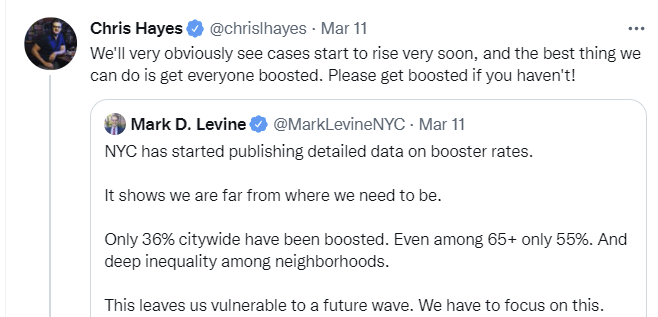
A call that BA.2 means another wave for NYC, and if it doesn’t another one will come along anyway, so in a lull now is the time to impose additional mandates and generally get ready for doomy doom doom doom. A lack of a problem means we must Do More.
Doom. Doom, like war, never changes.
There will always be More to Do, we will always be Vulnerable. If it does not come, we were still Vulnerable, and should have Done More. If it does come, even more so, no matter how little impact it has, or how much of that impact falls on those who made the choice to not Do More.
A claim that wastewater concentrations are surging in many places.

Ah yes, more of the calling for Doing More. No link back to the source but here’s the chart.
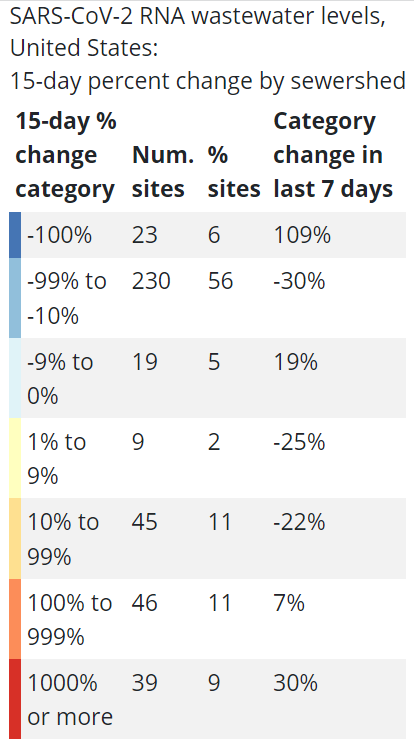
This is what one might call ‘ludicrously noisy.’ This is a problem for wastewater efforts when there are not a ton of cases. Nine percent of monitoring had a tenfold increase in those fifteen days with national cases crashing? Twenty percent doubled or more? I can’t take that seriously, any more than I take seriously that 6% of sites found actual nothing. And 67% of cites still had decreases. When you look at state data, you see uniform declines. Wastewater is great data but we can’t take it too seriously as individual data points. Instead we must aggregate.
So is that wave actually coming?
BA.1 vs. BA.2
Thread on vaccine effectiveness and waning vs. both BA.1 and BA.2, based on a new study from Qatar. Bottom line is that vaccines sustainably are highly effective versus severe disease and death (90%+ for the booster) but protection against infection declines with time and was never that great. Which mostly matches previous understandings, although there are signs that vaccine might be slightly less effective against infection by BA.2 even though protection against death seems the same.
If anything, BA.2 might be slightly less severe than BA.1.
That’s not the concern, though. The concern is whether it will cause a wave of cases.
It seems clear that BA.2 is outcompeting BA.1.

The CDC estimate in question has been proven to be (let’s be polite) somewhat unreliable.

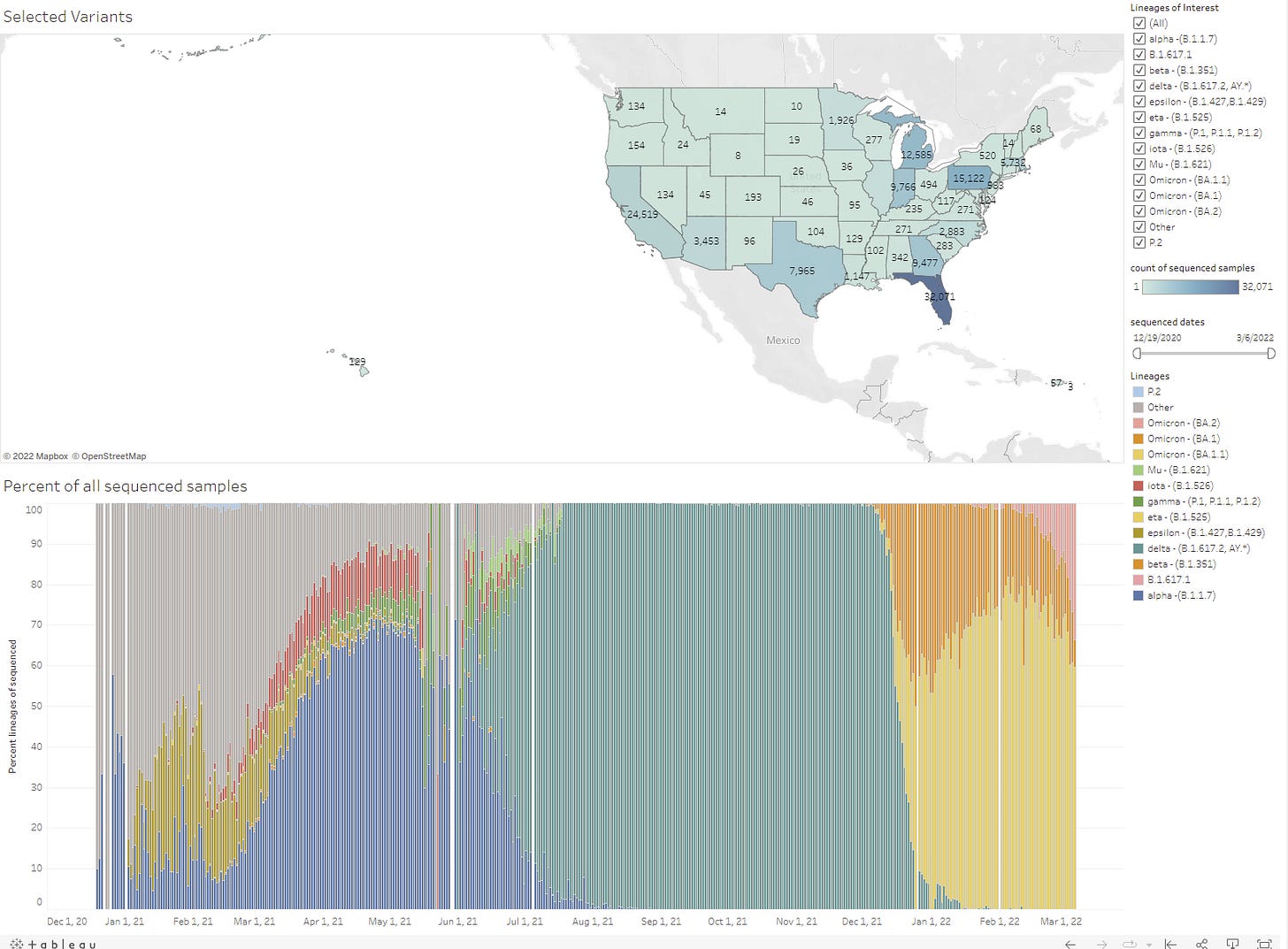
The pink is BA.2, and these are raw numbers, it’s easier to see at the site.
An interesting note is that the most BA.2 sequences are in Pennsylvania, Florida, Texas, Michigan and California. Obviously there’s some size bias there, but there seems to be zero correlation between BA.2 sequences found and amount of decline in cases in the past week. If BA.2 was going to be a huge issue, you’d have expected to see this.
The CDC projection is representing about a 15%-25% more infectious strain. The other option is noisier and harder to pin down, but suggesting higher if you look at the very recent events.
If you squint, you can see a BA.2 sample recorded on January 6, and there were a number of reports about it earlier than that. If we go backwards from 23% now with a 25% reproduction advantage every three days (which seems generous), then that would imply something like 0.2% of Omicron cases were B.2 on January 6. That I suppose is possible, and the rest of the graph looks vaguely consistent with that. So it’s likely something in that range.
Cases are declining by ~30%/week during the last few weeks, but that still means cases of BA.2 are rising.
The good news is, it doesn’t mean they’re rising all that much. I get R0 ~ 1.03 for BA.2, with cases down by 36% for BA.1, and up by 7% for BA.2 over the week, to average out to -30%.
That’s still a little scary, since it adds up over time and we could reasonably worry that prevention efforts will decrease or that weather or other cyclical conditions will worsen, and one way or another we’ve got another wave and the need to bring back a bunch of prevention.
The new variant typically has an early advantage, and the margins here are small, so it could easily go any number of ways. There’s still reason to think the resulting wave if it happens will not get that large, and also strong reason to think it will not be very lethal.
From all accounts, BA.2 and BA.1 give full cross-immunity, so the weird part of all this is why didn’t BA.2 dominate from the start? Or, if it didn’t do that, why was there enough of it early on for us to know about it from the start? For now I am assuming it started out well after BA.1 and thus there was very little of it, and we heard about it so early because it’s the kind of thing people like to talk about.
My bottom line here would be that BA.2 might cause something of a bump or even a wave, but it is unlikely to be sufficient to justify a general reversal of restrictions.
The Federal Funding

Both are rather terrible, but on different levels.
The future pandemic request was asking a lot of Congress, but still: White House asks for $65 billion for pandemic prevention, gets less than $2 billion, but at least gets funding for an ‘after action report’? Something is better than nothing, so thread reporting this still wants the PREVENT bill to pass.
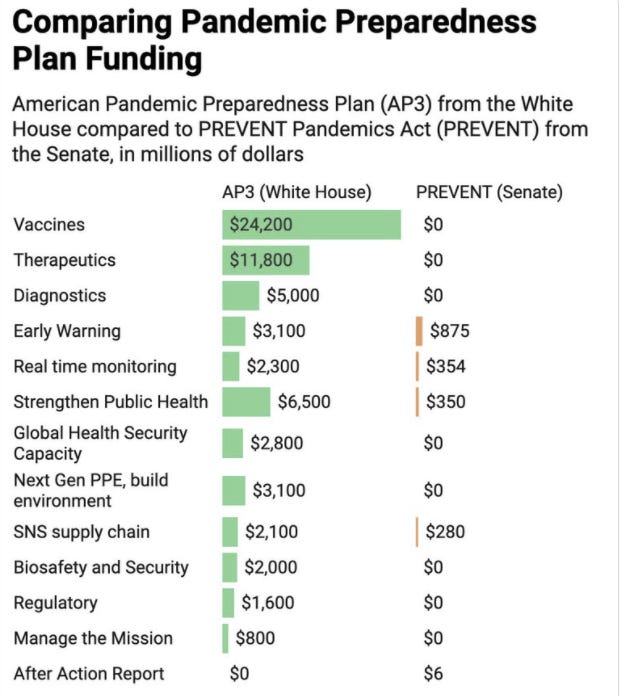

In theory, one can always also increase funding in addition to the various actions in the bill.
In practice, this is another sign that congress has zero intention of allocating serious money to things that won’t have an impact before the next election and does not expect pandemic preparedness to backchain in the minds of many voters.
Then there’s the bigger practical problem that we have zero current pandemic funding.

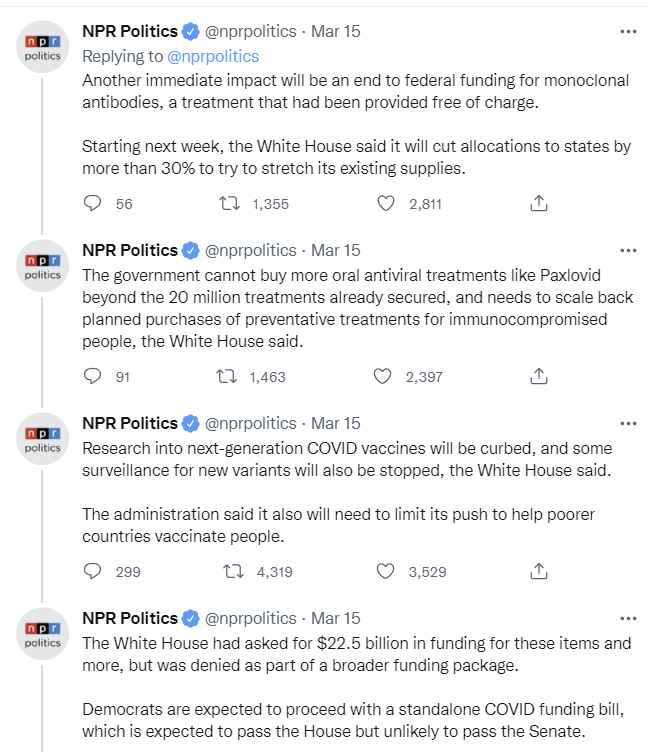
I continue to presume that if there was another surge that this would be largely fixed, but in a world in which one side is determined to spend whatever is given to them then use that to ask for more, and the other side wants to limit spending, there is no easy way to get things to line up.
The UK also is dropping the ball on pandemic funding, although not on the same level.

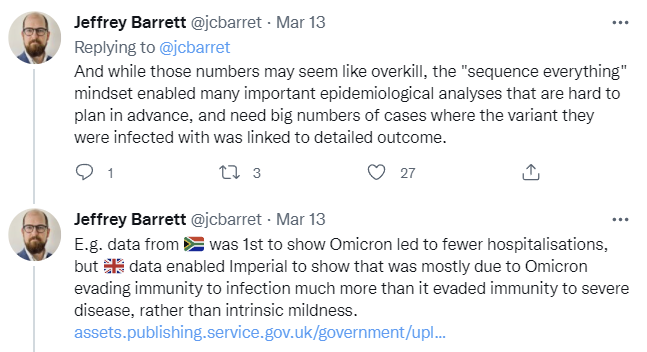

There’s a lot of that going around including in areas that have nothing to do with Covid, this idea that once things are gone we cannot get them back. That what was once built cannot again be built, what was once assembled cannot be again assembled. There’s a fixed supply of a wide variety of Nice Things that is grandfathered in, but now any such things are not permitted. One of the central challenges we face is reversing this dynamic. I wish I had a better line on how.
Prevention and Prevention Prevention Prevention
Some hospitals continue to tell people to remove their N95s and replace them with inferior surgical masks, luckily when my wife gave birth we did not have this issue. If a hospital tells you to use an actively worse mask, would you trust them to treat you?
A suggestion that Biden should mask because he is old and therefore vulnerable (which is a good reason, it is important that he stay healthy especially now) and also ‘because we are likely to see a new surge in the next week or two’ which would indicate that masks work at preventing future infections.
Biden administration extends transportation mask mandate for another month before it was set to expire on March 18. It would have been better if it had expired, but the length of the extension being so short is encouraging. There’s a good chance this will be allowed to die in April if conditions continue to improve.
One unfortunate side effect of this requirement is to discourage use of trains and buses, which then get substituted with cars, which in turn increases our reliance on and drives up the price of oil and gas. Given the Democratic love (that I share) of public transportation, this seems like an excellent time to move to increase ridership and even push for additional (electrified!) buses and trains. Instead, we are implying they are unsafe and also making them unpleasant. Never waste a crisis.
As for masks on airplanes, that requirement remains deeply silly, but fully in line with many other silly safety theater related to airplanes.
It is good news is that the Senate voted 57-40 to override the transportation mandate. All Republicans except Romney voted in favor. Romney’s justification is that public health officials should make such decisions. Which is odd, since he’s met public health officials, but I guess I understand how he got there. Alas, it takes a two-thirds majority to override a presidential veto, and I can’t see Biden signing this.
Scotland re-imposes mask mandate due to rise in cases. We may see a lot more of this in Europe. I’m hopeful we won’t see it in that much of the United States unless we see a very large rise, and perhaps not even if then.
Thread on some attempts to ease the logistics of vaccination.
Think of the Children
CDC Data Tracker had some very serious issues in need of fixing. Which were then (at least partially) fixed this week, substantially reducing pediatric deaths. This was blamed on a ‘coding error.’ So let it be known – pediatric deaths are substantially lower than previously reported.
MIT lifts its mask mandate, flips to a mandate against masking requests.

I can certainly see why one might do that – if you allow requests then refusing a request is going to be quite socially awkward at best.
Scary headline requiring explanation: A third of all USA child Covid deaths came during the Omicron wave. True as far as it goes. That was 550 deaths. Each death is a tragedy, but then the post goes on to claim that it is clear that ‘something different’ was happening.
“Omicron really did something different than Delta, and I don’t think it was just because more kids were infected,” Kane said. He saw younger patients with illnesses similar to croup and bronchiolitis, which can be dangerous in young children with “a pediatric airway the diameter of a pencil”, he said.
“It’s no longer fair even to insinuate that Covid doesn’t affect children, that Covid deaths are only in unhealthy children or kids with risk factors. That’s just not true, by the data.”
Was it?
Here’s cumulative American cases:

So that’s 150,000 cases per million before Omicron, and 100,000 cases of Omicron per million. Omicron was 40% of cases and caused 33% of child deaths.
That does not sound to me like things were suddenly worse, especially since a larger portion of Omicron cases were missed. Yes, kids were partially vaccinated, and this does show that Omicron was perhaps not as much relatively mild in children because of how much more mild it was in adults. But in children it’s still even more mostly harmless than previous variants, by the article’s own stats.
Varying school mask mandate lifting timelines in Canada’s provinces.


In Other News
More Dakka, taking something that is working and doing more of it, does not always work, and lockdowns were a prime example of that (short video). In order for More Dakka to be worthwhile, you need one of two things. Either you need all marginal additions to be worthwhile in and of themselves (e.g. gratitude is good and more gratitude on sane margins is better, so use more) or you need there to be a clear threshold where it would work and a mechanistic reason why and reason to expect to be able to hit that threshold. In the video’s example of trench warfare there simply was not threshold that would work. For Covid-19, there in theory was of course a threshold that would have worked if sustained sufficiently long but this was well outside the realm of serious possibility.
Note that the video this is part of was removed from YouTube for ‘violations of community guidelines’ before I could watch it, presumably for saying true things in violation of the Narrative. If anyone has a full link, please share. This guy seems great.
Dick Nixon of Twitter, an excellent account, gets stuck in UK without the funds to return home after getting Covid, forced to ask for help.
Situation in Hong Kong is quite grim, as elderly were mostly unvaccinated.

If you see one complete failure to shut up and multiply, you should expect additional complete failures both of shutting up and also of multiplying. I would expect these two positions to correlate rather than anti-correlate, even controlling for other political stances, despite the contradiction Jeremy is pointing towards.
There may not be a cure for this (it’s a 45 second video of a very paranoid and deluded woman) but I have to say, pretty creative, very Scott Alexander, I like it.
Washington Post algorithms may need updating, they are still linking in their Coronavirus page to this article about what you need to know about Delta.
Prediction Markets
I was reminded recently that I haven’t checked prediction markets for a while in the context of Covid, so seems like a good time to do that for Polymarket – for Covid I am still skeptical that Metaculus and other sources are all that useful.
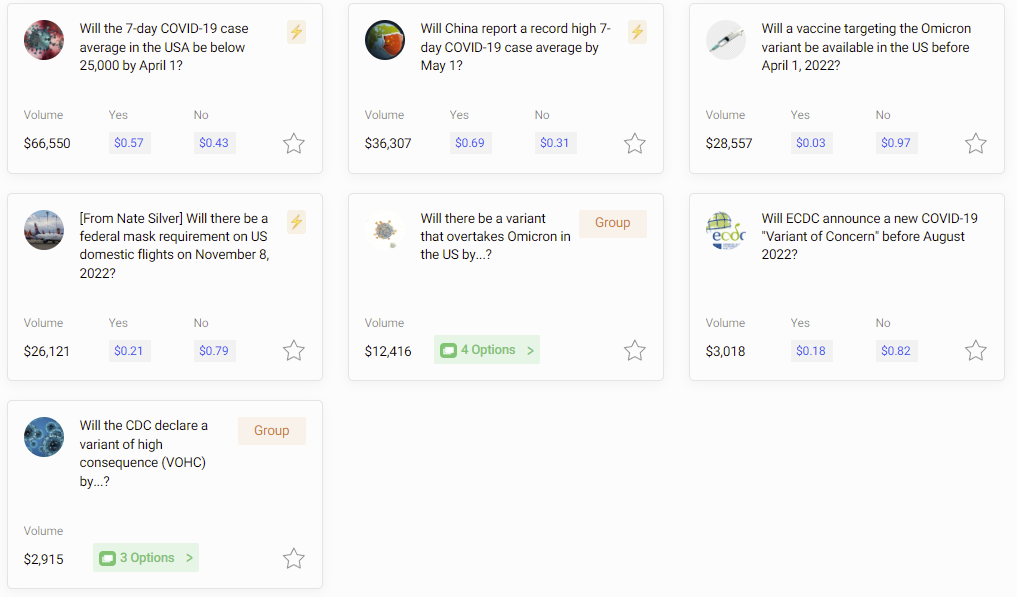
China hitting a record high was a buy before someone took the other side. It’s a screaming buy at 69%. There is not that much farther to go here.
Will we hit a 25k case average or lower by April 1? We are remarkably close to hitting it now, but BA.2 is likely to start creeping things back up. My default scenario has us barely missing this, so I think 57% is somewhat high and I’d have this more like 40%, but very sensitive to the next few days of measurements – even one surprisingly high day should probably crash this quite a bit.
The vaccine targeting Omicron by April 1 is trading at 3%. I consider this mostly an opportunity to collect interest at low risk. I suppose if your money is doing nothing else and is already in the right place collecting the interest is better than doing nothing.
Will there be a mask mandate in place on election day 2022? Currently this is at 21%, and the Senate has signaled strongly it wants this gone, but the vote would not have happened if there was any risk it would lead to a bill becoming law. This is up to a bunch of health experts and Biden, so I suspect that 21% is low here, although not enough to tie up money this long. I’d have this at more like 30%.
Will Omicron be overtaken? For some reason the April market is at 6%, that’s basically Free Money, a new variant that was detected now likely wouldn’t take over until after the deadline.
The Variant of High Consequence markets seem high, but not sufficiently obnoxiously high given time discounting.
Not Covid
Friends are great, so be friendly and make some friends.

These predictions are remarkably well-ordered. There are only a small number of ‘surprising’ answers once you draw a basic regression line. Smartphone being at 80% makes sense as an outlier. The 40% guess for black population is strange but I’m guessing that’s because people are thinking about all minorities combined. Household income over $100k is interesting in that it is correct, would have expected a number in the 40s there, not sure the story, especially given the 50% for over $50k.
I am curious what would happen if you pointed out contradictions. For example, if people think 40% of Americans are black and 59% are white and 24% are Asian, and that’s 133%. Which is a lot.
What would be the sum of the guesses for all 50 states, I wonder.
Mostly though this seems like an excellent way to tell what people really think.
If some (ordinary person or an aggregate group) guesses that less than 30% of people have an attribute, it’s super rare. And if they think it’s more than 50%, they’re underestimating. So small differences near 50% are a big deal.
This also mirrors prediction market bias, although of course it’s bigger since the average prediction market user is more numerical.
Another possibility is simply that it doesn’t take many stupid guesses to get the answer very wrong when the right answer is 2%. Which is also an issue for prediction markets.
It’s also a reminder that those one talks to are weird. There are a lot of these where my bubble is off by a factor of ten or more.
Another note is that if it’s true that only 1% of Americans are transgender, 3% are gay and 4% are bisexual then that’s definitely not reflected in the broader culture and no adjustment of what numbers means is going to fix that. I’m actually highly suspicious that those numbers are that low.
And of course, there are some obvious errors on this chart. If you think only 3% of Americans are atheists I’m pretty sure you’re wrong. If you tell me 47% are Republicans, I know you’re wrong, Democrats outnumber them and there are a lot of independents as well.
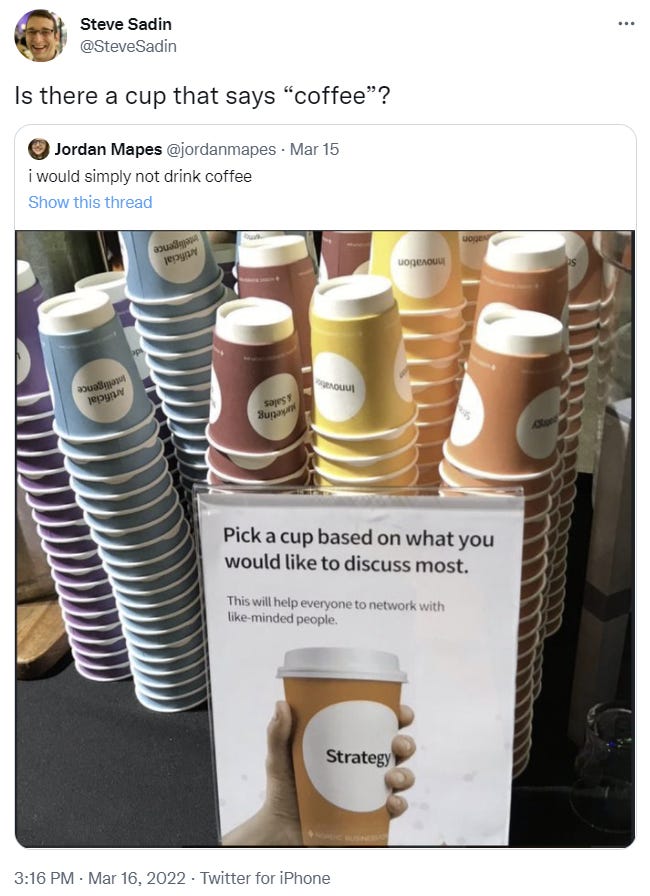
Permanent Daylight Savings Time Ho?
It’s called the “Sunshine Protection Act” rather than the “Stop Making Us Fix All Our Clocks Twice A Year Act,” the “On Time Act” or the “Time Stops Flying Act,” which makes me sad, but it was sponsored by Rubio so that makes sense.

Then again, could be dumber.

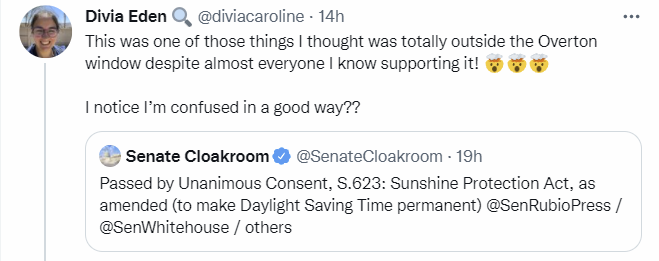

Secretly and Suddenly Do The Right (or at least Better) Thing Unanimously Senate is indeed the best Senate. There is some threshold where things stop being played for politics and the necessary thing simply happens.
I do think that Standard Time was the correct answer, of course. It being dark at 8am for weeks on end is not good, we should have gone the other way. But switching between them is obviously worse.
In other words: The best time is an hour ago. The second best time is right now.

“Balance means failure. There is no ‘keep the economy operating within a reasonable range’ other than winning, and then resuming the work.”
This does not make sense to me. Covid is worse than your average influenza. It is not remotely as bad as the Spanish flu.
Deaths are heavily loaded towards higher ages, people who are not economically productive.
The bottom line is, every last person in China could come down with Covid, and there’d be a lot funerals, and then the Chinese leadership would look at their age demographics and hide a grin. And the economy would keep working right through all of it.
Sure, that’s a pretty morbid take on the matter, but it’s still true: Covid is simply not killing enough people in their economically productive years to be an economic threat. It’s the response to Covid that has caused the economic damage, not the disease itself.
As a senior myself, with some friends that are still older, I don’t take this lightly. But I don’t think we should exaggerate things, either.
” It being dark at 8am for weeks on end is not good,”
I don’t much understand this, either. They’re just numbers. Adjust your schedule. Buy a flashlight. Changing the clock isn’t changing the reality.
I used to live far enough North, close to the 45th parallel, that the seasonal changes in day length were huge. Days were more than twice as long in summer as in winter. You coped. Changing the clocks didn’t make the days longer in the winter, or shorter in the summer.
First one looks like simple failure to communicate on my part. What I meant was that if you ‘keep the economy running’ then everyone gets Covid. Which we both agree is a reasonable and probably the only option – I simply meant that anyone who thinks a balanced approach would contain Covid is fooling themselves.
Your schedule does not get to depend on you. Schools start when they start, so this means kids getting on buses at 6am in some places – I personally had to get up at 6:45am in pitch dark for many years with zero choice in the matter. Many jobs require you to start at 9am (and my trading job had me starting at 7:30am). Etc.
No one’s saying you won’t cope and I’m happy about the change ,but yes this is a downside.
With South Korea and Hong Kong we should get a test of the actual consequences of “hospital collapse” in a first world country. The standard assumption is that this is very bad (~3x CFR) but this is mostly theoretical.
When you observe that deaths not falling more/faster may not make sense, is that because your mental model has a peg to case counts? Could case counts today be underrepresenting true cases by more than (hypothetical) yesterday? I’m curious if the rise in at-home testing, and the government’s free testing kits in particular, which arrived about a month ago for me, have influenced the relationship between cases and deaths. Speaking for myself, I tested positive on Monday and that test result won’t make it into any official data sources. I know three other close friends who are positive right now and they’re not getting PCR’s or reporting their results either. Anecdotally I know more people with covid today that I did on Jan 17th or on any particular day during the first Omicron phase. Which is totally out of synch with official case counts.
It does not seem plausible that cases are being increasingly under-represented, given that at the peak getting tests was actively dangerous and difficult and now it’s trivial and easy. It does not make sense to me? My model says we were missing a TON of cases at the peak.
I’m not sure if we can compare US cases and EU cases at this point.
I’d bet that most of US positives are not captured in the data, as a lot of people is going to make the test with the free-test at their on home and just report to work that they got sick. I doubt this cases are going to be taken into account in the official data.
On the other hand, in EU, even if you got positive with an at-home test, you are going to the doctor in order to receive the official medical sick leave. Meaning that it will count towards official statistics.
When I had looked at the Helix data before, it was only for tests that their company ran. So in addition to a size bias, there’s also a states-where-Helix-tests bias.
“For example, if people think 40% of Americans are black and 59% are white and 24% are Asian, and that’s 133%. Which is a lot.”
this depends on whether we conceive of mixed-race people as belonging equally to multiple groups or belonging to a separate category.
i personally tend to view people who are mixed race, especially half/half, as being “both” races rather than “neither” race., so in my mind they basically get counted twice.
> Some hospitals continue to tell people to remove their N95s and replace them with inferior surgical masks, luckily when my wife gave birth we did not have this issue.
Did your wife give birth wearing an N95?? Or no mask at all?
——————————————————————————————————–
> It being dark at 8am for weeks on end is not good, we should have gone the other way. But switching between them is obviously worse.
Pretty surprised at your strong language here. Normally you’re a cautious and strong analytical thinker, so the use of “obviously” really stands out. It doesn’t follow to me that removing the biannual switch is worth the cost of losing an hour of morning sunshine during the season we need it most.
Here is a great post that outlines the tremendous health benefits of morning sunlight: https://herf.medium.com/why-standard-time-is-better-e586b500923
The post goes into great detail on the myriad health impacts of morning sunlight and I’d strongly recommend at least skimming it, but let me focus on one point in particular: the historical precedent. At a minimum you should have a good answer for the fact that the United States tried this in 1974 and Russia in 2011, and both times the policy was quickly reverted. The US policy only lasted a single winter! Tell me, *what has changed since then*? Certainly not human chronobiology.
To me, this seems like a better use of the word “obviously”; obviously since this policy has been tried in the past and failed it doesn’t make sense to try again (unless we have some reason to think this time will be different).
This proposal seems like a classic failure to think the policy through. Even the title reveals that: the “Sunshine Protection Act”. No sunshine is being protected or added here! I will conclude by excerpting what is perhaps the strongest sentence in that entire piece I linked:
> It’s important to remember that initial enthusiasm for year-round DST does not mean that we’ve felt what it feels like to go through a winter without light in the morning.
I assure you that anybody living in the Northern tier of states knows quite well what it feels like to go through a winter without light in the morning. When I lived in Michigan, I literally would not see the sun except at lunch and on weekends, during the winter. A lousy one hour clock shift isn’t going to compensate for only six hours of daylight.
Sorry Brett, this is a lousy counter-argument that essentially amounts to “well I grew up with leaded gasoline and I’m just fine, so why do we need to ban it?” The health effects of morning sunlight are well established (did you even click the article I linked?), even if people have the ability to adapt to some degree. The fact that some people work night shifts or on nuclear submarines where there is not sunlight does not negate this.
I am a bit disappointed that Mr. Zvi himself did not reply with his thoughts. I very much wanted to hear what he had to say in response.
She was allowed to give birth without a mask, as the alternative is completely absurd.
Arguing about the word usage here seems non-useful – I think it is transparently obvious that having a consistent measure of time is correct, and having to adjust it twice a year is super annoying and confusing and disruptive. As I said, I would choose Standard instead, and one happy result is if we end up switching to that instead if this is so bad. But also, if it’s so bad, you can just… adjust when things are scheduled. I’m a morning person, and I’ve TOTALLY had to go to school for months with no light in the past, so I know how this works, but people should then simply not force that kind of thing on other people. Sheesh.
This might be an old topic, but…at this point, what is justification for getting a booster? I’ve had the two doses of pfizer, and my current thinking is: this is good protection against severe disease/death, booster protection against infection wanes heavily after like 6 weeks anyways, I’m 40, far better than average health, so…why not save a booster for sometime in the future when something worse than omicron comes along?
booster has permanent beneficial effects – not as big as its short term effects, but 3 and done is a lot better than 2 and done.
Where is this described in a way that you find definitive? I keep reading benefits in the context of higher antibody levels and non-age-segregated charting, but that’s about it.
(Sorry wish I could edit comments) also…I couldn’t even get boosted until late February (not in the US), and given a) the likelihood of asymptomatic or really-mild cases in the omicron wave + the recommendation not to get tested if just kind of feeling down, and b) the recommendation to delay vaccination until 2 months after infection (did I feel sick? yes but not significantly) …this is something else I think about.
Sorry about the stream of consciousness.
Alas I do not have one definitive source and one thing I haven’t had time for is to compile everything into easy-to-reference resources, but this has been a very clear theme. I debated doing The Long Vaccine Post but basically sigh.
Thanks Zvi, your productivity is amazing even without a long vaccine post.
What would you put the % chance at for Novavax being FDA EUA approved (as a primary dose at least) and available here in the USA by the end of May?
I have some plans that may rely on that happening, assuming that vax requirements still exist in any private organizations by late summer.
I’d say this is unlikely, simply because the FDA sees no need for it and they don’t do things they don’t need to do. 20%?
Appreciate the answer, even though it is disappointing to me. Thanks. I guess I should think of some other way around it if the chance is that low.
“Another note is that if it’s true that only 1% of Americans are transgender, 3% are gay and 4% are bisexual then that’s definitely not reflected in the broader culture and no adjustment of what numbers means is going to fix that. I’m actually highly suspicious that those numbers are that low.”
Perhaps you should be highly suspicious that media portrayals of the broader culture are inaccurate? The simplest explanation for some of these survey results is that people are modeling society off what they see in popular media, and *popular media are radically unrepresentative of society*.
Strong agree here, for a bunch of reasons. The LGBT people are even more geographically concentrated than you think they are, mostly by choice. There are lots of places in America where you might never see a gay person except on TV, and even more such places outside the US. I know, because I’m from such a place in the US, and I currently live in a similar place outside the US.
I mean ‘suspicious’ doesn’t apply when you know something is inaccurate. But it also occurs to me that most media portrays the young, and the young numbers are likely much higher given cultural trends.
>>> “The optimistic picture is that things work out like they did in Japan (or like Omicron in India). A rapid rise, but then a peak well before the situation turns critical and everyone is overwhelmed, somehow managing to turn things around while most remain uninfected.”
Very minor point, but this is not how I would describe how things worked out in India for omicron. I think most people in India did get infected by omicron, it’s just that no one was immunologically naive anymore, and people were not keen on testing.
crazy_pills.gif
I just called two hospitals, an urgent care clinic and two pharmacies. The hospital operator was not aware that oral treatment for covid exists, nobody knows anyone who will prescribe it or who would have it. Except for the local CVS, who has it sitting on the shelf, hasn’t seen a prescription for it in over a week, and confirms that doctors are free to prescribe. Told my cousin who just tested positive, she calls her doc back up, they put her on hold for a long time then come back with a questionnaire and conclude she’s not particularly high risk and thus may not have a prescription.
Googling “Paxlovid” “my_state’s_name” turns up fluffy news articles from months ago and nothing else. Clicking HHS map turns up monoclonals and molnupiravir but not paxlovid. Insanity.
Looks like maybe the FDA (delenda est) is possibly the culprit: https://www.fda.gov/media/155050/download
“…who are at high risk for progression to severe COVID-19”
I’m more sympathetic on this one than usual, because supply remains limited, so long as they change the rule when supply is no longer limited. For now even keeping for a stockpile seems reasonable versus giving it to young healthy people with mild cases, so we’re talking price.
I hear this anecdotally, distressingly often. Specifically:
– that doctors aren’t aware of its existence*;
– that even if a patient informs them a treatment exists**, doctors find that policies and procedures won’t allow it to be given;
– that if you need the treatment, you need to have a specialist at a large hospital, one who’s well-connected enough to successfully prescribe it for you.
Same story for Evusheld and immunocompromised or otherwise vulnerable people. There’s just no awareness in the general clinical community, and when that’s fixed there are unjumpable bureaucratic hoops in the way.
… I guess we can take comfort in the fact that the response to COVID remains consistent and predictable in its quality.
—
*facepalm
**double facepalm
It is in fact correct that only 3% of Anericans identify as atheists, although the number of people who will say they identify as either atheists or agnostic or “nothing in particular” are about 23%. So there’s a distinction between people who identify as “atheists” and people who just don’t strongly believe in any particular religion.
https://www.pewforum.org/religious-landscape-study/
Something similar is likely going on here with the gay/bisexual/trans numbers, where only a few percent of the population identify as those terms but that may not accurately describe the number of people who feel that way (the higher number among younger generations strongly implies that to me.)
I’ve been wanting to ask this here for a long time and never found a good opportunity. This seems to be a good a time as any. This is a serious question, not anti-vax.
Where did we get the idea that the vaccines would prevent _all_ infection long term and that circulating antibody levels is a good indicator of your protection against severe disease?
I understand if you have large amounts of circulating anti-bodies because you recently had a vaccine you may be immune from infection. I also understand the vaccine should prevent symptomatic infection – that is the whole point.
But otherwise this goes against everything I think I understand about how the immune system works.
My lay understanding is that the immune system works on memory. We have immunity to hundreds (thousands?) of possible infections in T-Cell (or B?) MEMORY.
We are NOT actively producing anti-bodies for ALL of those ALL of the time. When you GET INFECTED with one of those pathogens, your immune system uses the memories to produce anti-bodies. This may or may not rise to the level of symptomatic infection each time but protects you none the less.
I would expect most people, most of the time, to have NOT anti-bodies actively circulating for 99%+ of the things they are immune to.
So how did we get to the point where “does the vaccine still prevent ALL infection months / years later?” and “do uninfected still have high circulating antibody levels?” as important things to measure and study?
I feel like the whole world collectively forgot how long term immunity works and I’m going crazy.
What am I missing here?
The ‘prevents ALL infections’ in an individual thing was… well honestly hell if I know that’s absurd, 95% is not 100%. Basically was never an honest thing.
Antibodies are not a perfect proxy, but they’ve so far proven a pretty good one in terms of infectiousness. Then there’s a second layer of protection has you describe, where you still get infected at all but it doesn’t end up being serious.
But basically people are bad at this and rounded stuff off?
Yes, I understand the media brain-holing us re:Maddow says vaccine stops all covid in it’s tracks, etc. circa late 2020 early 21.
I was more talking about: Many serious people, including here on your posts have often used serum anti-body levels as evidence in favor of boosters, booster timing etc.
This never made any sense to me for the reasons listed in my OP.
>Antibodies are not a perfect proxy, but they’ve so far proven a pretty good one in terms of infectiousness.
That might be the key to my misunderstanding.
If keeping personal anti-body levels constantly high for long periods is key to reducing infectiousness to others – as separate from how good is your personal disease outcome likely to be – that is worthy of studying and optimizing for.
However – I have never seen that distinction made explicitly and it seems an important one. But maybe I have not been reading closely enough – words have meanings and all.
It is certainly one key to reducing infectiousness to others. It’s not the complete picture, but it helps a lot, or at least that’s the going model.
So our beloved Zvi is a Standard-Timer even though that is objectively wrong and evil (the correct choice: year round DST!). Sad. Next thing we will learn is that prefers round pizza cut into squares, or some other incredibly perverse thing.
You take that back!
One possible cause of the discrepancy between forecast and actual deaths (and the implied increase in IRF) may be due to some states reporting suspect Covid deaths in their daily totals From the IMHE Covid Results Briefing of Feb 4. page 1
“Daily deaths have exceeded the level expected but appear to be peaking. The higher reported deaths than expected is in part due to many states reporting suspect deaths in their daily death totals; suspect deaths are deaths with a positive test in the last 60 days regardless of cause of death on the death certificate.”
Click to access 102_briefing_United_States_of_America_0.pdf
Don’t know if this is true or the extent of the issue if true but given the surge in cases over the last 60 days, potentially a higher percentage of deaths than in the past would meet this definition. I couldn’t find a list of states reporting suspect deaths in this way, but if this were true then implied IFR’s would differ strongly by state and there would likely be a pattern of IFR’s being relatively stable over time in some states and then increasing dramatically in others. If state level implied IFR’s were similar and all were showing an increase then some other factor would be in play
Yep, this is the basic theory that the deaths are coincidental with-Covid deaths rather than of-Covid deaths, and that seems like the right answer.
Regarding permanent Daylight Saving Time: I am in the minority in that I’d prefer we scrap it globally in favour of Standard (`winter´) time (IMO we should also scrap non-whole-hour offset time zones and countries ought to choose which hour(s) they want to use). The situation as it stands now makes it very confusing for coders and other people who deal with time in multiple countries, with different places going on/off DST on different dates. The situation even parts of the US is weird: Arizona overall doesn’t do DST, but in the Navajo areas they do DST, then in the Hopi areas they do not do DST. This results in many time changes if you travel across every boundary there. In Canada there is an entire province that doesn’t do DST. Question for the US: If the new permanent DST law goes into effect, can states still decide which time zone to use? If so, they can get around it by just choosing a new time zone.
I presume states could choose but I don’t know. I’m with you on DST, as noted elsewhere – I want Standard Time, and I also agree that the half-measures are dumb too.
https://marginalrevolution.com/marginalrevolution/2022/03/shut-ins.html
Closet shut-ins coming out (metaphorically) because of COVID!
You might want to do a long NPI post – how likely are for restrictive ones to persist, how likely will some people keep doing them long after acute threat from COVID is gone, and what are the politics, economics and psychology (not to mention public health trade-offs) behind those.
I’ve also changed my attitude to NPIs locally (in HK) a bit and more accepting of it because we already have the highest dead per capita per day now – lots of bottlenecks and gridlocks leading to the sorry state now. https://marginalrevolution.com/marginalrevolution/2022/03/hong-kong-and-shenzhen.html
At least there’s a plan for gradual reopening without ditching contact tracing and vaccine passports, which are points of contention for sizable Trumpist-inspired antivaxxers:
https://news.rthk.hk/rthk/en/component/k2/1640053-20220321.htm
(Sorry for misthreading this; I can’t figure out how to reply to the main post.)
The video with the Battle of the Somme Covid-response analogy by retired Canadian Lt. Col. David Redman that was taken down from YouTube is now up on BitChute:
https://www.bitchute.com/video/iWDKDi6PTULq/
I listened to the whole thing and thought it was quite good; he highlights some phenomena LessWrong readers will recognize. The visuals are not needed: it’s just a talking head and subtitles for the interviewer’s questions. I think the interview is from December 2020 or January 2021, so bear that in mind while listening. There’s also a transcript at the link above.
(The video, which solely features Redman for an hour, unaccountably misspells his last name as “Redmond”. Everywhere else on the Internet, it’s “Redman”.)
I apologize, I thought there was a transcript, but now can’t find it.
To make up for it, here are some of Redman’s writings, which almost certainly make the same points:
https://fcpp.org/authors/david-redman/
And here’s a list of podcasts he’s been on:
https://www.listennotes.com/top-episodes/david-redman/
The Mitigation-Preparedness-Response-Recovery model he talks about has been around for at least 20 years; I’ve found it applicable to non-emergency risks as well.